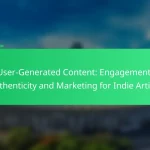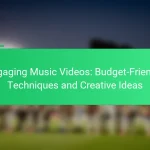Visual storytelling is a powerful tool for indie artists, enabling them to craft a distinctive brand identity that resonates with their audience. By blending imagery, color, and personal narratives, artists can forge meaningful connections and amplify their impact in a crowded music scene. Through compelling visuals, they can effectively communicate their message and foster deeper relationships with their fans.

How Can Indie Artists Use Visual Storytelling for Branding?
Indie artists can effectively use visual storytelling to create a memorable brand identity that resonates with their audience. By combining imagery, color, and personal narratives, they can forge deeper connections and enhance their overall impact in the competitive music landscape.
Creating a Unique Visual Identity
A unique visual identity is essential for indie artists to stand out. This includes a consistent style across all visual elements, such as album covers, social media graphics, and merchandise. Artists should consider their genre and personal aesthetics when developing their visual identity to ensure it aligns with their music and message.
To establish a strong visual identity, artists can create a mood board that reflects their artistic vision. This can include colors, fonts, and imagery that resonate with their brand. Regularly updating and refining this identity helps maintain relevance and keeps the audience engaged.
Leveraging Color Psychology
Color psychology plays a crucial role in visual storytelling, as different colors evoke specific emotions and associations. Indie artists should choose a color palette that reflects their music’s mood and themes. For example, warm colors like red and orange can convey passion and energy, while cool colors like blue and green can evoke calmness and introspection.
When selecting colors, artists should consider their target audience and cultural contexts, as color meanings can vary across different cultures. A well-thought-out color scheme can enhance brand recognition and create a lasting impression on listeners.
Incorporating Personal Narratives
Incorporating personal narratives into visual storytelling allows indie artists to connect with their audience on a deeper level. Sharing stories behind songs, experiences, or inspirations can create an emotional bond and make the artist’s brand more relatable. This can be done through visual content like music videos, behind-the-scenes footage, or social media posts.
Artists should aim to be authentic in their storytelling, as genuine narratives resonate more with audiences. Regularly sharing personal insights can help build a loyal fan base and encourage engagement, making the audience feel like part of the artist’s journey.
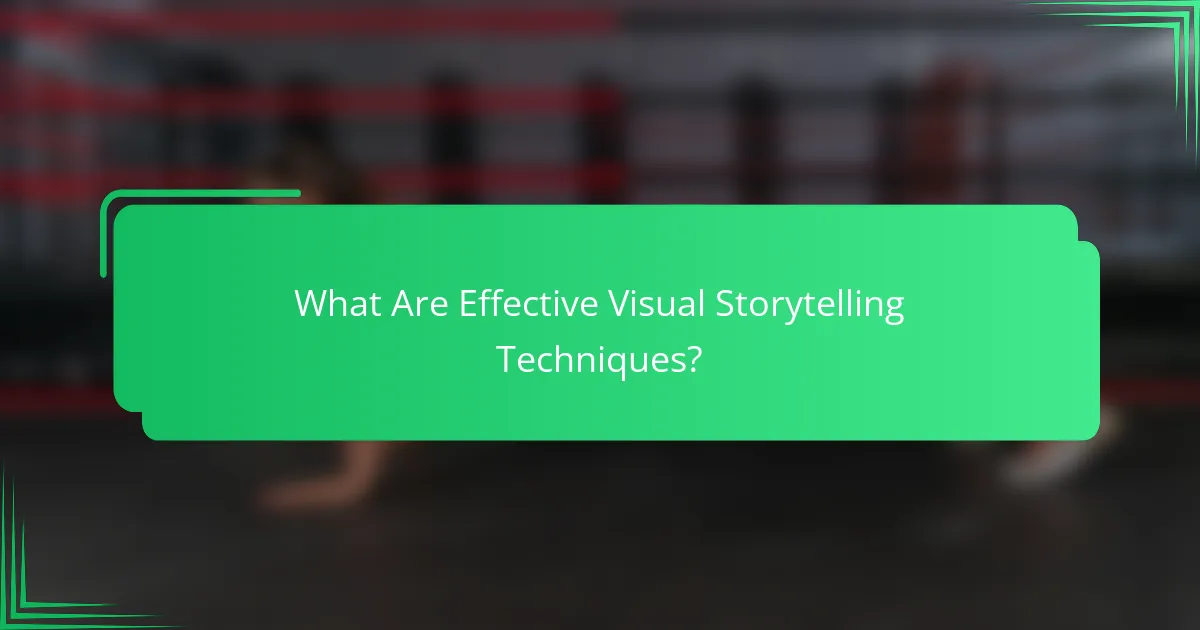
What Are Effective Visual Storytelling Techniques?
Effective visual storytelling techniques engage audiences by combining imagery and narrative to convey a brand’s message. Indie artists can utilize various methods to create compelling visuals that resonate with their audience and enhance their brand identity.
Using Photography and Videography
Photography and videography are powerful tools for visual storytelling, allowing artists to capture moments and emotions that words alone cannot convey. High-quality images and videos can showcase an artist’s personality, style, and creative process, helping to build a deeper connection with the audience.
When using photography, focus on composition, lighting, and subject matter to create striking visuals. For videography, consider storytelling techniques such as pacing, sound design, and editing to enhance the narrative. A consistent aesthetic across both mediums can strengthen brand identity.
Implementing Graphic Design Elements
Graphic design elements, such as typography, color schemes, and layouts, play a crucial role in visual storytelling. These elements help to create a cohesive look that reflects the artist’s brand and message. Using design software or hiring a professional can elevate the quality of graphics used in promotional materials.
Consider creating a style guide that outlines preferred fonts, colors, and imagery to maintain consistency across all visual content. This approach not only reinforces brand recognition but also ensures that all materials align with the artist’s overall narrative.
Utilizing Social Media Platforms
Social media platforms are essential for indie artists to share their visual stories and engage with their audience. Each platform has unique features that can be leveraged, such as Instagram’s emphasis on imagery and TikTok’s focus on short videos. Tailoring content to fit these formats can enhance visibility and connection.
Regularly posting high-quality visuals, behind-the-scenes content, and engaging stories can foster a loyal following. Utilize analytics tools to track engagement and adjust strategies based on audience preferences. Avoid overposting or using irrelevant visuals, as this can dilute the brand message and disengage followers.
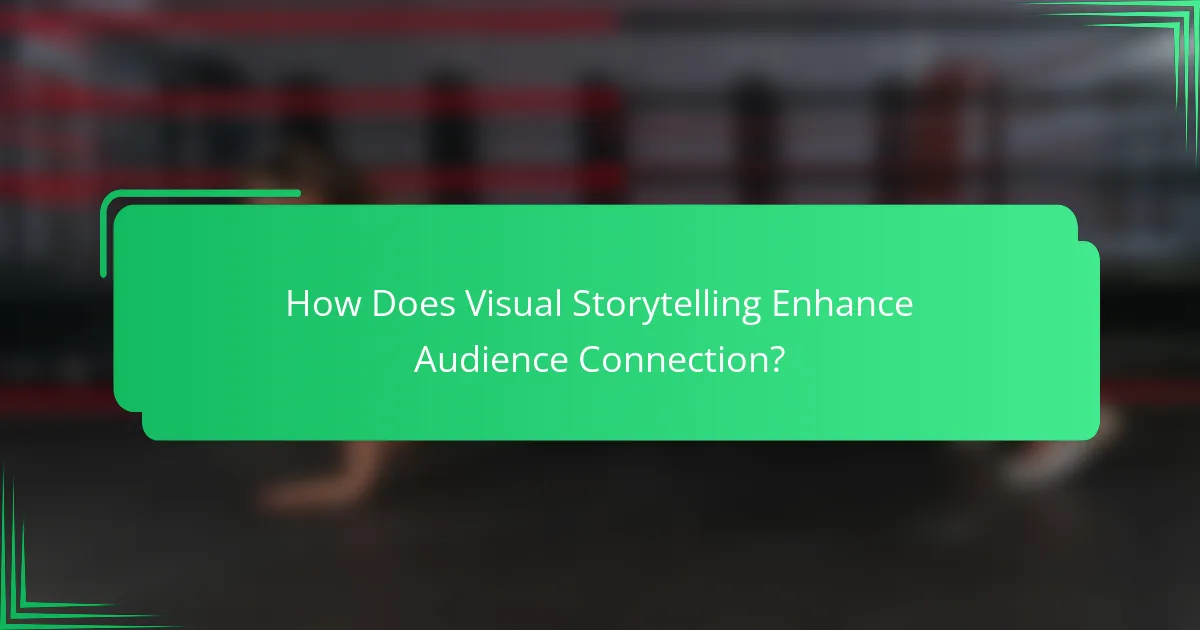
How Does Visual Storytelling Enhance Audience Connection?
Visual storytelling enhances audience connection by creating compelling narratives that resonate emotionally with viewers. By using images, videos, and graphics, indie artists can convey their brand message more effectively, fostering a deeper relationship with their audience.
Building Emotional Engagement
Emotional engagement is crucial for indie artists as it helps to forge a strong bond with their audience. By sharing personal stories through visuals, artists can evoke feelings that resonate with their fans, making them more likely to support their work. For example, behind-the-scenes footage or personal anecdotes can create a sense of intimacy and authenticity.
To effectively build emotional engagement, artists should focus on relatable themes and experiences. Using color psychology can also enhance emotional responses; warm colors may evoke excitement, while cooler tones can instill calmness. Regularly sharing content that reflects the artist’s journey can keep the audience emotionally invested.
Fostering Community Interaction
Community interaction is vital for indie artists looking to cultivate a loyal fan base. Visual storytelling can encourage fans to engage with the content by prompting discussions, sharing their own stories, or participating in events. For instance, hosting live Q&A sessions or interactive polls can make fans feel valued and involved.
Artists should consider creating dedicated spaces, such as social media groups or forums, where fans can interact with each other and the artist. Regularly responding to comments and sharing fan-created content can further enhance this sense of community, making fans feel like they are part of the artist’s journey.
Encouraging User-Generated Content
User-generated content (UGC) is a powerful tool for indie artists to amplify their brand message. By encouraging fans to create and share their own visuals related to the artist’s work, it fosters a sense of ownership and loyalty. For example, artists can run contests or challenges that invite fans to submit artwork or videos inspired by their music.
To effectively encourage UGC, artists should provide clear guidelines and incentives, such as featuring fan submissions on their official channels or offering exclusive merchandise. This not only boosts engagement but also enriches the artist’s narrative with diverse perspectives and creativity from their audience.
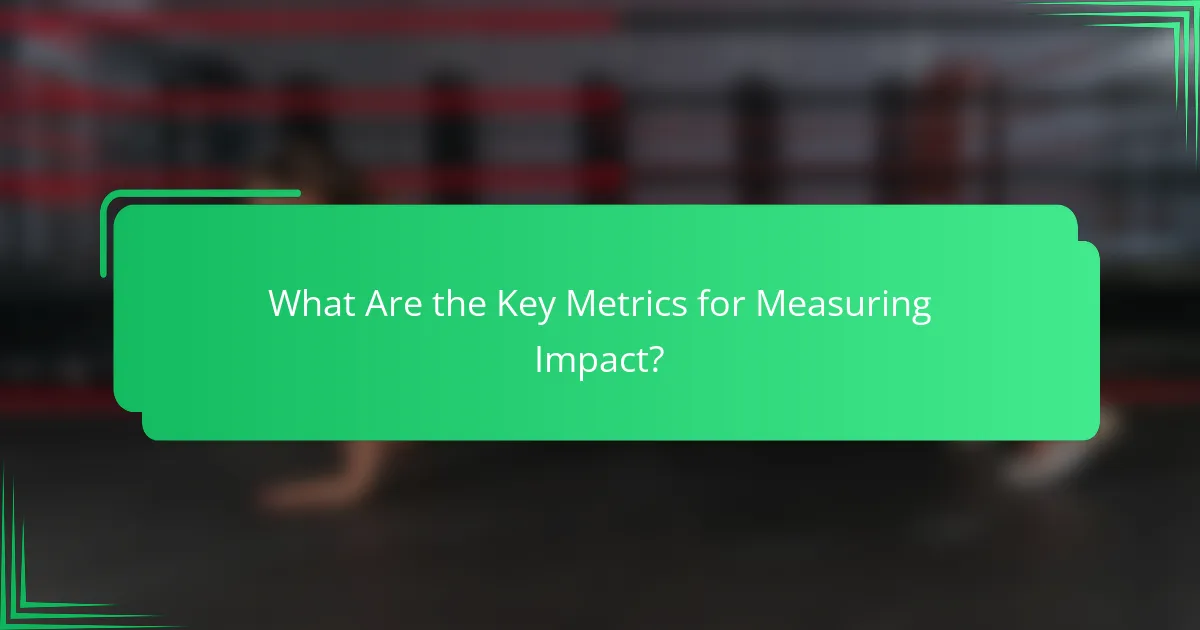
What Are the Key Metrics for Measuring Impact?
Key metrics for measuring impact in visual storytelling include engagement rates, audience growth, and conversion rates. These metrics help indie artists assess how effectively their branding resonates with their audience and drives desired actions.
Tracking Engagement Rates
Engagement rates measure how actively your audience interacts with your content. This can include likes, shares, comments, and time spent viewing your visuals. A good engagement rate typically falls between 1% to 5% for social media platforms, but this can vary based on the platform and your audience size.
To track engagement, use analytics tools provided by social media platforms or third-party services. Regularly review these metrics to identify which types of content generate the most interaction, allowing you to refine your storytelling approach.
Analyzing Audience Growth
Audience growth indicates how your following expands over time, reflecting the effectiveness of your branding efforts. This can be tracked through follower counts, subscriber numbers, or website traffic. A steady growth rate of 5% to 10% monthly is often considered healthy for indie artists.
To analyze this metric, compare growth over specific periods, such as monthly or quarterly. Look for patterns that correlate with specific campaigns or content types, and adjust your strategy accordingly to maintain or accelerate growth.
Evaluating Conversion Rates
Conversion rates measure how many audience members take a desired action, such as purchasing merchandise or signing up for a newsletter. A typical conversion rate for indie artists might range from 1% to 3%, depending on the effectiveness of your call-to-action and audience targeting.
To evaluate conversion rates, set clear goals for what actions you want your audience to take and use tracking links to monitor these actions. Regularly test different approaches, such as varying your messaging or visuals, to see what drives higher conversions.
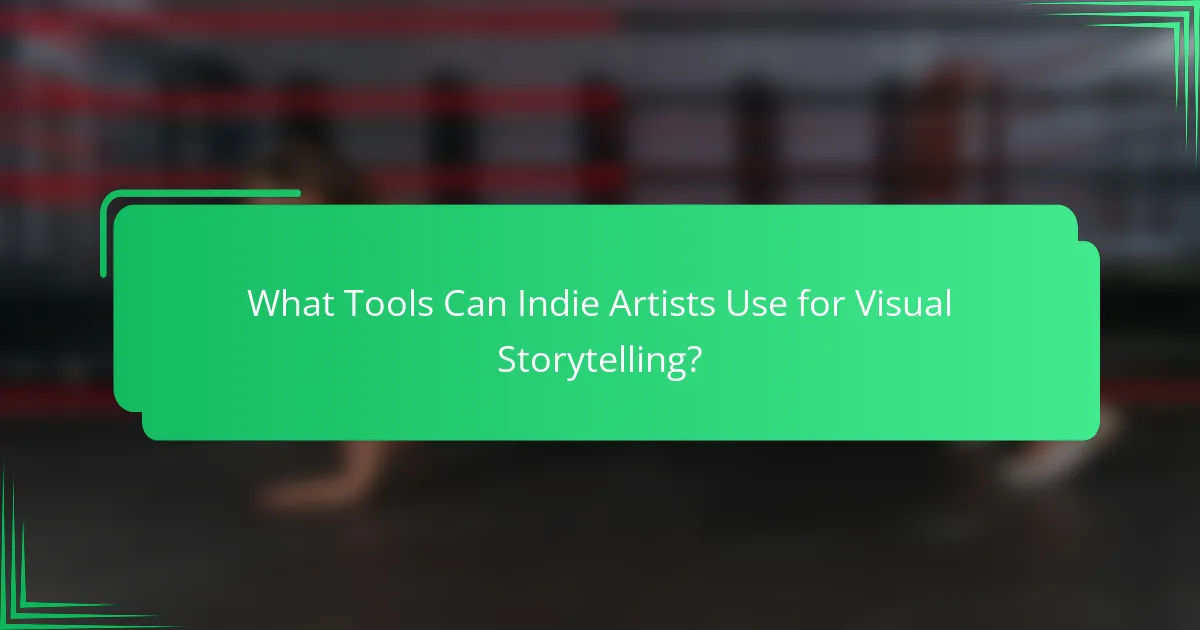
What Tools Can Indie Artists Use for Visual Storytelling?
Indie artists can leverage various tools for visual storytelling to enhance their branding and connect with their audience. These tools simplify the creation of engaging visuals, allowing artists to express their unique narratives effectively.
Canva for Graphic Design
Canva is a user-friendly graphic design platform that enables indie artists to create stunning visuals without needing advanced design skills. With a vast library of templates, images, and fonts, artists can easily customize their graphics for social media, posters, or album covers.
To get started, choose a template that fits your project, then adjust colors, text, and images to reflect your brand. Keep in mind that while Canva offers a free version, the premium features can enhance your designs significantly.
Adobe Spark for Video Creation
Adobe Spark is an intuitive tool for creating short videos that can tell compelling stories. It allows indie artists to combine video clips, images, and text to produce engaging content suitable for platforms like Instagram and Facebook.
When using Adobe Spark, focus on keeping your videos concise and visually appealing. Aim for a duration of 30 seconds to 1 minute to maintain viewer interest. The platform also provides various themes and music options to enhance your storytelling.
Instagram for Visual Content Sharing
Instagram serves as a powerful platform for indie artists to share their visual content and connect with their audience. By posting images, videos, and stories, artists can showcase their work and engage with followers in real-time.
To maximize your impact on Instagram, maintain a consistent aesthetic and post regularly. Utilize features like hashtags and geotags to increase visibility. Engaging with your audience through comments and direct messages can also foster a loyal community around your brand.
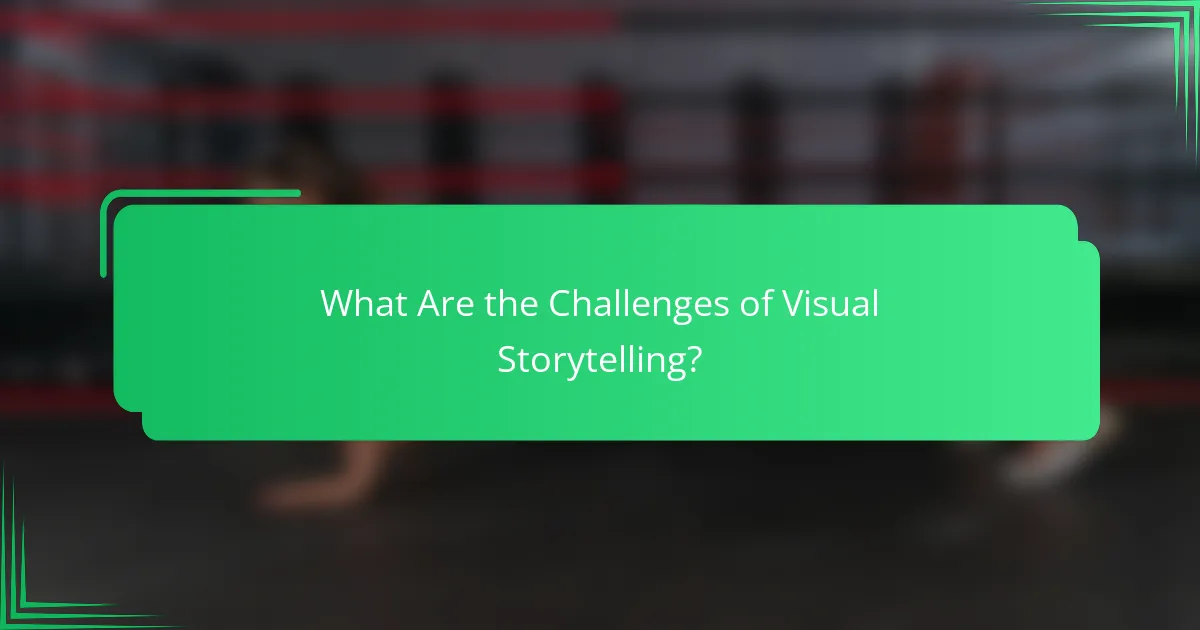
What Are the Challenges of Visual Storytelling?
Visual storytelling presents several challenges for indie artists, including effectively conveying their message, engaging their audience, and maintaining brand consistency. These hurdles can impact how their work is perceived and can limit their reach in a competitive market.
Understanding Your Audience
Identifying and understanding your audience is crucial for successful visual storytelling. Indie artists should research their target demographic to tailor their visuals effectively. Consider factors such as age, interests, and cultural background to create relatable content.
Engagement can be enhanced by using visuals that resonate with the audience’s experiences. For instance, using familiar symbols or themes can create a stronger emotional connection, making the storytelling more impactful.
Creating Consistent Visuals
Consistency in visuals helps establish a recognizable brand identity. Indie artists should develop a cohesive style that reflects their artistic vision while appealing to their audience. This includes color schemes, typography, and imagery that align with their overall message.
To maintain consistency, artists can create a style guide that outlines their visual elements. This guide serves as a reference for all future projects, ensuring that their storytelling remains aligned with their brand.
Balancing Creativity and Clarity
Finding the right balance between creativity and clarity is essential in visual storytelling. While unique and imaginative visuals can capture attention, they should not overshadow the core message. Artists must ensure that their visuals clearly communicate their story.
One effective strategy is to use a clear focal point in each visual. This helps guide the audience’s attention and reinforces the main idea. Additionally, artists should seek feedback from peers or target audience members to gauge the clarity of their visuals.
Adapting to Different Platforms
Different platforms have varying requirements and audience expectations, which can complicate visual storytelling. Indie artists should adapt their visuals to fit the specific characteristics of each platform, whether it’s social media, websites, or print.
For example, visuals for Instagram should be highly engaging and visually appealing, while those for a website may require more informative elements. Understanding these nuances can enhance the effectiveness of the storytelling across various channels.

